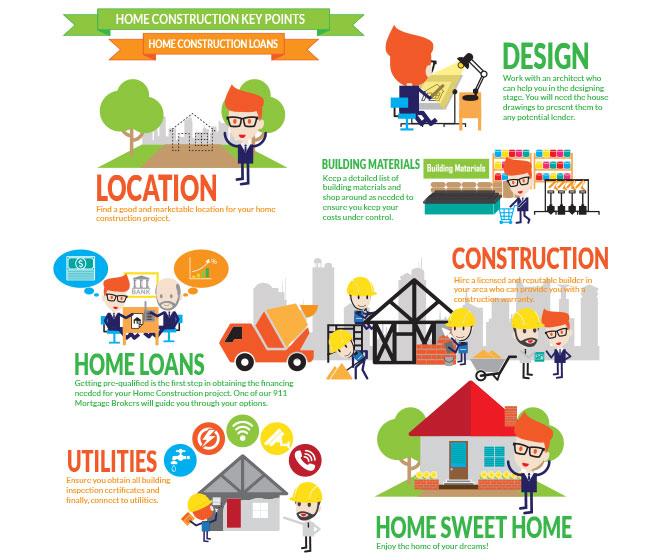Home Construction Loans
Home Construction Loans
What is a Home Construction Loan?
A construction loan allows you to borrow money in order to have your own home constructed for you, rather than buying an existing home. This gives you the ability to build your own home from the ground up. You can select a plot of land, design the house, and eventually construct the home itself.
Key Points About Home Construction Loans
- Construction loans allow you to finance building custom homes.
- You don’t receive the total mortgage value upfront. Instead, you receive four payments with each construction milestone.
- Construction mortgage rates are generally higher than conventional mortgages.

How are Home Construction Loans different from Mortgages?
Home construction loans differ from regular mortgages in the loan term and when you receive access to the loan. Home construction loans are meant to be a short-term way for you to finance your new home constructions, with money disbursed in stages of construction. On the other hand, mortgages apply to existing homes, can have longer terms, and have lower interest rates.
How Do New Construction Loans Work?
Construction loans are also called draw mortgages. Construction draws is the process of your lender providing financing to you, which you will then use to pay contractors and for supplies. Your lender may provide the funds to your lawyer, who in turn will disburse the funds to your contractor. Other lenders might only deal directly with the contractor. Regardless of who gets the money from the bank, they usually require a construction plan or a budget for the project. It is important to have a clear budget to increase the chances of getting the loan. You may talk to the contractor directly or use different calculators to estimate the amount of resources a project requires. For example, if you are building a staircase, you can use a stair calculator to estimate how much material you will need for that project.
Draws are paid out in stages of the home construction process. This means that the contractor does not receive the entire loan amount upfront to build your home. Instead, the contractor will only receive money proportionate to the completion of the house. This ensures that the construction loan funds are used towards constructing the home.
Most lenders will allow you to borrow up to 75% of the construction cost. This means that you will need to pay for 25% of construction costs out of your pocket.
If you are not using a general contractor or a home builder, a self-build construction loan provides financing if you are building your home yourself. However you will need to have the necessary experience to do so.
Construction Draw Schedules

A construction draw schedule outlines when construction draws are paid. A draw schedule is negotiated before construction begins by the contractor. While the bank might already have a standardized draw schedule, your contractor or the bank’s appraiser may propose alternate payment schedules. This can be due to differing construction timelines or costs. Construction draw schedules can be based on milestones, such as when the foundation or roof is complete, or a general percentage of the total home finished.
Interest only starts incurring once each construction draw is disbursed. As a borrower, you may want to receive draws as late as possible to reduce interest costs during construction. On the other hand, the contractor would want to receive their pay as early as possible. If your contractor or lender proposes an alternative payment schedule, you should review it to ensure that it allows your contractor to be paid on time, but is also reasonable.
How Many Construction Draws Can I Receive?
Most lenders, such as banks, usually only allow four draws. Other lenders can be more flexible and allow a greater number of draws. Your lender will send an appraiser to check on the progress of the home before a draw is paid. An inspection fee can be charged each time, depending on your lender.
Do I have to make monthly payments on construction draws?
You still have to make monthly payments on your home construction loan, even if construction is ongoing and your home is not occupied. Some lenders only require monthly interest-only payments during construction. You will be required to make principal and interest payments once construction is complete.
Some construction lenders may even allow you to use future construction draws to pay for interest on the loan.
How do I Qualify for a Construction Loan?
If you already own the land, the home construction loan would be based on the home construction costs. If you do not already own the land, we may look at obtaining separate financing for the land itself, however you might be expected to cover the vacant land purchase cost with your own money.
One of our 911 Mortgage Brokers will guide you through your home construction loan options. In many ways, the process is similar to applying for a conventional mortgage, however, as the collateral for a construction home is an unfinished home (which has less value than a fully finished home), construction loans are riskier for lenders and therefore the interest rates are usually higher than interest rates for existing homes.
Before making any decisions, the first step is to go through the Pre-qualification process to ensure you have the financing required from start to end.


